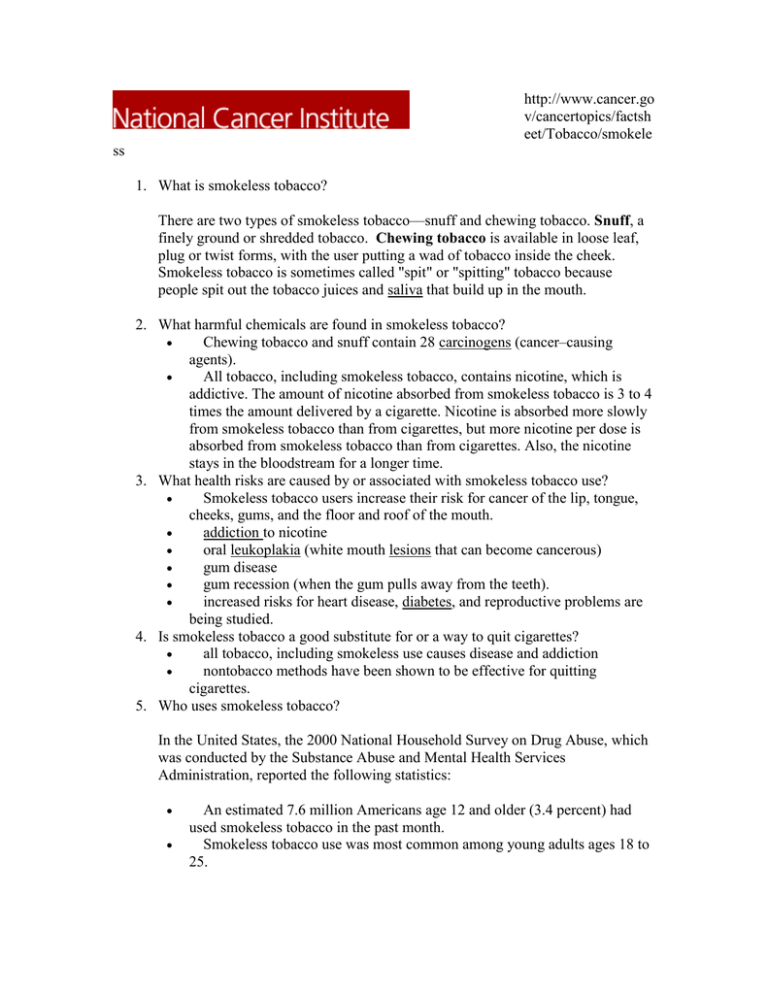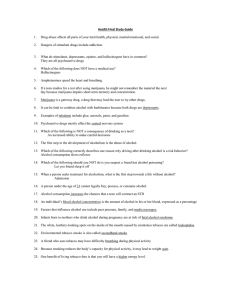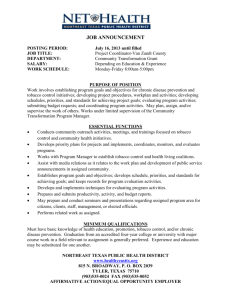v/cancertopics/factsh eet/Tobacco/smokele ss
advertisement

http://www.cancer.go v/cancertopics/factsh eet/Tobacco/smokele ss 1. What is smokeless tobacco? There are two types of smokeless tobacco––snuff and chewing tobacco. Snuff, a finely ground or shredded tobacco. Chewing tobacco is available in loose leaf, plug or twist forms, with the user putting a wad of tobacco inside the cheek. Smokeless tobacco is sometimes called "spit" or "spitting" tobacco because people spit out the tobacco juices and saliva that build up in the mouth. 2. What harmful chemicals are found in smokeless tobacco? Chewing tobacco and snuff contain 28 carcinogens (cancer–causing agents). All tobacco, including smokeless tobacco, contains nicotine, which is addictive. The amount of nicotine absorbed from smokeless tobacco is 3 to 4 times the amount delivered by a cigarette. Nicotine is absorbed more slowly from smokeless tobacco than from cigarettes, but more nicotine per dose is absorbed from smokeless tobacco than from cigarettes. Also, the nicotine stays in the bloodstream for a longer time. 3. What health risks are caused by or associated with smokeless tobacco use? Smokeless tobacco users increase their risk for cancer of the lip, tongue, cheeks, gums, and the floor and roof of the mouth. addiction to nicotine oral leukoplakia (white mouth lesions that can become cancerous) gum disease gum recession (when the gum pulls away from the teeth). increased risks for heart disease, diabetes, and reproductive problems are being studied. 4. Is smokeless tobacco a good substitute for or a way to quit cigarettes? all tobacco, including smokeless use causes disease and addiction nontobacco methods have been shown to be effective for quitting cigarettes. 5. Who uses smokeless tobacco? In the United States, the 2000 National Household Survey on Drug Abuse, which was conducted by the Substance Abuse and Mental Health Services Administration, reported the following statistics: An estimated 7.6 million Americans age 12 and older (3.4 percent) had used smokeless tobacco in the past month. Smokeless tobacco use was most common among young adults ages 18 to 25. Men were 10 times more likely than women to report using smokeless tobacco (6.5 percent of men age 12 and older compared with 0.5 percent of women). People in many other countries and regions, including India, parts of Africa, and some Central Asian countries, have a long history of using smokeless tobacco products. 6. Where can people find help to quit using smokeless tobacco? Several national organizations provide information about the health risks of smokeless tobacco and how to quit: The National Institute of Dental and Craniofacial Research offers a booklet that discusses spit tobacco use in a colorful and graphic format. It is designed specifically for young men who have decided to quit or are thinking about it. Organization: National Oral Health Information Clearinghouse National Institute of Dental and Craniofacial Research Address: One NOHIC Way Bethesda, MD 20892–3500 Telephone: 301–402–7364 E–mail: nidcrinfo@mail.nih.gov Web site: http://www.nidcr.nih.gov/HealthInformation/Diseases AndConditions/SpitTobacco/default.htm The Centers for Disease Control and Prevention's Office on Smoking and Health provides fact sheets, educational materials, reports, and related materials on smokeless tobacco. Organization: Centers for Disease Control and Prevention Address: 1600 Clifton Road, NE. Atlanta, GA 30333 Telephone: 1-800-232-4636 (1-800-CDC-INFO) E–mail: tobaccoinfo@cdc.gov Web site: http://www.cdc.gov/tobacco/smokeless/index.htm The mission of the National Spit Tobacco Education Program (NSTEP) is to prevent people, especially young people, from starting to use tobacco, and to help users to quit. NSTEP offers information and materials on spit tobacco use, prevention, and cessation. Organization: National Spit Tobacco Education Program Oral Health America Address: Suite 352 410 North Michigan Avenue Chicago, IL 60611 Telephone: 312–836–9900 Web Site: http://www.nstep.org The American Cancer Society provides information about smokeless tobacco and techniques for smokeless tobacco users who want to quit. Organization: American Cancer Society Address: 1599 Clifton Road, NE. Atlanta, GA 30329 Telephone: 1–800–227–2345 (1–800–ACS–2345) Web site: http://www.cancer.org The American Academy of Family Physicians has a fact sheet with information on how to quit using smokeless tobacco. The fact sheet is available at http://familydoctor.org/online/famdocen/home/common/addictions/tobacco/177.ht ml on the Internet. Organization: American Academy of Family Physicians Address: 11400 Tomahawk Creek Parkway Leawood, KS 66211–2672 Web site: http://familydoctor.org A number of other organizations provide information about where to find help to stop using smokeless tobacco. State and local health agencies often have information about community tobacco cessation programs. The local or county government section in the phone book (blue pages) has phone numbers for health agencies. Information to help smokers who want to quit is also available through community hospitals, the yellow pages (under "drug abuse and addiction"), public libraries, health maintenance organizations, health fairs, and community helplines. 7. What other resources are available? A person's dentist or doctor can be a good source of information about the health risks of smokeless tobacco and about quitting. Friends, family members, teachers, and coaches can help a person quit smokeless tobacco use by giving them support and encouragement.


